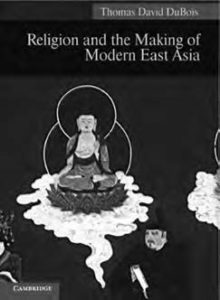BY THOMAS DAVID DUBOIS
CAMBRIDGE UNIVERSITYPRESS, 2011
272 PAGES, ISBN: 978-1107008090, HARDBACK
 Undoubtedly, the vast majority of surviving art produced in both the Western world and Asia in the past millennia has been religious in subject. From an art historical perspective, the significant role religions play in shaping the creative visual expression of cultures is obvious. Historians more often tend to view history from political, economic, military, and, in recent years, social perspectives— presenting life lived in palaces or government ministries, or on battlefields, farms, or shops. Thomas David DuBois, professor of history at the National University of Singapore, takes a fresh approach to East Asia by examining the history of ideas, most fully embodied in religions, as a means to explore the “big themes of history” (3), arguing that “religion is more than just ideas: it is ideas in action” (2). He relates the evolution of both native and foreign religions in China and Japan to the critical events and people shaping East Asia’s historical developments.
Undoubtedly, the vast majority of surviving art produced in both the Western world and Asia in the past millennia has been religious in subject. From an art historical perspective, the significant role religions play in shaping the creative visual expression of cultures is obvious. Historians more often tend to view history from political, economic, military, and, in recent years, social perspectives— presenting life lived in palaces or government ministries, or on battlefields, farms, or shops. Thomas David DuBois, professor of history at the National University of Singapore, takes a fresh approach to East Asia by examining the history of ideas, most fully embodied in religions, as a means to explore the “big themes of history” (3), arguing that “religion is more than just ideas: it is ideas in action” (2). He relates the evolution of both native and foreign religions in China and Japan to the critical events and people shaping East Asia’s historical developments.
As the title suggests, the author propels his historical-religious chronicle into the present, a somewhat surprising feature given the tumultuous route religions have taken in the past sixty years in both nations—especially under Communist China’s suppression of religious institutions after ascending to power in 1949 and Japan’s postwar renunciation of State Shinto. But DuBois weaves the threads of his story—and he is a very able storyteller—seamlessly right up to current times, including a coda on how East Asian religions have made an impact in the West.
The book divides into two meta-narratives. The first occupies the first five chapters and tells the familiar story of China’s and Japan’s history, extending into the beginning of the modern era: the Chinese Qing dynasty (1466–1911) and Japanese Tokugawa Shogunate (1603–1868) periods, with his uniquely shaped emphasis on the religious developments of these regions— indigenous Confucianism and Daoism in China and Shinto in Japan and foreign-born Buddhism and Christianity in both (with a brief nod to Islam in China). Each chapter weaves back and forth between the two nations during concurrent centuries, presenting some surprising assessments of familiar events. Meaningfully, the author includes parallel examples with Western history and religion, as well as defends his religious focus on history by arguing, “nobody would think to write a history of the Western world without including religion” (1).
Each chapter weaves back and forth between the two nations during concurrent centuries, presenting some surprising assessments of familiar events.
The start of chapter six marks the beginning of the second narrative, and it comes with a startling discourse on millennialism, beginning with Seventh-Day Adventists in the US. The author contends that such apocalyptic ideations in Asia, usually peripheral in historical narratives, must be examined seriously, for “in order to begin to understand a religion that is not your own, it is important, vital, to develop a sympathy for its beliefs, ethics, rituals, and aesthetics” (125). A 1967 poster of Mao Zedong’s smiling face rising like a radiant sun over rebels marching to overthrow American Imperialism (129) clearly articulates the Communist leader’s messianic fulfillment of six centuries of apocalyptic fervor expressed by various sects collectively referred to as bailian jiao, the White Lotus Teaching. These groups were fueled by the cumulative conditions of agricultural successes, leading to overpopulation and ensuing mass poverty, resulting in the killing of unwanted daughters and producing desperate “bare branches” men with no hope for wives, who thus turned to violent rebellion—the most destructive of which was the Taiping Rebellion that killed some twenty million in the mid-nineteenth century. Millennial thinking also gave rise to jingoistic State Shinto in Japan that elevated the Meiji emperor to the position of an unassailable god and suppressed Buddhism as a foreign ideation blamed for bringing disaster to Japan upon the invasion of American warships in the port of Edo in 1853.
In another lengthy but fascinating tangent, chapter nine begins by discussing Karl Marx’s theory of religion, its brutal translation in Soviet Russia, and more nuanced interpretation by Mao. The postwar era has also witnessed the continued creation of millennial sects, some of which are known from news accounts in the West, such as Chinese Falungong or Japanese Aum Shinrikyo. Today, both Christianity and Confucianism are also resurgent.
DuBois’s prose is engaging and accessible. It helps if the reader has some background in the history of East Asia when reading the first part, especially, because he sweeps through centuries, people, places, and events somewhat cursorily. Most helpful are the glossary and timelines in the back of the text, along with suggestions for further reading, but the comprehensive arc of his narrative may leave the untutored behind. For this reason, I am hesitant to recommend this text for high school teaching except to the most advanced groups. The book would supplement well other course texts on East Asian history or religion at the college and graduate school level.

